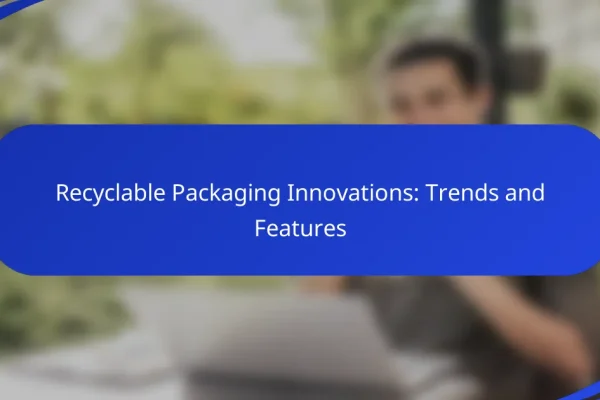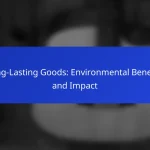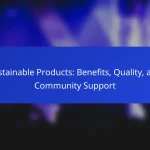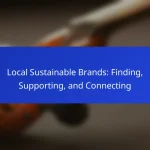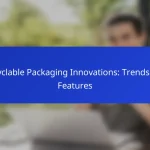What are the benefits of recyclable packaging?
Recyclable packaging offers numerous advantages, including reduced environmental impact and potential cost savings for businesses. By utilizing materials that can be processed and reused, companies can enhance their sustainability efforts while appealing to eco-conscious consumers.
Environmental sustainability
Recyclable packaging significantly contributes to environmental sustainability by minimizing waste and conserving natural resources. When materials are recycled, they require less energy and raw materials compared to producing new items from virgin resources.
For example, recycling paper can save trees and reduce water usage, while recycling plastics can decrease the demand for fossil fuels. This process helps to lower greenhouse gas emissions and supports a circular economy.
Cost savings for businesses
Businesses can experience cost savings through the use of recyclable packaging by reducing disposal fees and potentially lowering material costs. Many companies find that investing in recyclable materials can lead to long-term financial benefits.
For instance, some regions offer incentives or rebates for companies that utilize sustainable packaging practices. Additionally, as consumer demand for eco-friendly products grows, businesses that adopt recyclable packaging may gain a competitive edge, leading to increased sales.
Consumer preference for eco-friendly products
There is a growing consumer preference for eco-friendly products, with many shoppers actively seeking out brands that prioritize sustainability. This trend is evident across various demographics, particularly among younger consumers who are more likely to support companies with environmentally responsible practices.
By offering recyclable packaging, businesses can enhance their brand image and foster customer loyalty. Clear labeling and communication about recyclable materials can further attract eco-conscious consumers, making it essential for brands to highlight their commitment to sustainability.
How does recyclable packaging work?
Recyclable packaging is designed to be processed and reused after its initial use, minimizing waste and conserving resources. It typically consists of materials that can be collected, sorted, and transformed into new products through established recycling systems.
Materials used in recyclable packaging
Common materials for recyclable packaging include paper, cardboard, glass, and certain plastics like PET and HDPE. These materials are chosen for their ability to be efficiently processed and remade into new items, reducing the need for virgin resources.
When selecting recyclable packaging, look for symbols such as the recycling triangle with a number inside, which indicates the type of plastic and its recyclability. Familiarizing yourself with local recycling guidelines can help ensure proper disposal and increase recycling rates.
Recycling process overview
The recycling process begins with the collection of recyclable materials, which are then transported to a recycling facility. Here, materials are sorted based on type and cleaned to remove contaminants, ensuring high-quality recycled products.
After sorting, materials undergo various processes such as shredding, melting, or pulping, depending on the material type. Finally, the processed materials are formed into new products, ready to re-enter the market. Understanding local recycling rules can help maximize the effectiveness of this process, as regulations may vary significantly by region.
What types of recyclable packaging are available?
Recyclable packaging comes in various forms, each with unique properties and recycling processes. The most common types include cardboard, glass, and certain plastics, which can be processed and reused in new products.
Cardboard and paper packaging
Cardboard and paper packaging are widely recyclable and can be repurposed into new paper products. They should be clean and dry before recycling, as contamination can hinder the process.
Common examples include boxes, cartons, and wrapping paper. Many municipalities have curbside recycling programs that accept these materials, making it easy for consumers to participate.
Glass containers
Glass containers are highly recyclable and can be recycled indefinitely without losing quality. They are typically accepted in most recycling programs, but it’s essential to check local guidelines for specific rules regarding color separation.
Examples of recyclable glass include bottles and jars. Ensure they are rinsed and free of food residue to improve the recycling process and avoid contamination.
Plastic types and their recyclability
Plastics are categorized by resin identification codes, ranging from 1 to 7, which indicate their recyclability. Not all plastics are recyclable in every area, so it’s crucial to know which types your local facility accepts.
Commonly recyclable plastics include PETE (1) and HDPE (2), often found in bottles and containers. Avoid placing non-recyclable plastics, like polystyrene (6), in recycling bins to prevent contamination and processing issues.
How to choose recyclable packaging for e-commerce?
Choosing recyclable packaging for e-commerce involves selecting materials that can be easily processed and reused without harming the environment. Focus on materials that meet local recycling guidelines and ensure they protect products during shipping.
Consideration of product type
The type of product you are shipping significantly influences your choice of recyclable packaging. For fragile items, consider using recycled cardboard or biodegradable cushioning materials that provide adequate protection while being eco-friendly. For non-fragile products, options like paper-based mailers or compostable materials can be effective.
Additionally, consider the size and weight of your products. Lightweight items may not require heavy-duty packaging, allowing for thinner, recyclable options that reduce material use and shipping costs.
Shipping and storage requirements
Shipping and storage conditions are crucial when selecting recyclable packaging. Ensure that the packaging can withstand various environmental factors, such as moisture or temperature changes, during transit. For example, if your products are shipped in humid climates, opt for moisture-resistant recyclable materials.
Storage space is another consideration. Choose packaging that can be easily stacked or stored without taking up excessive space. Flat-pack designs or collapsible boxes can help maximize storage efficiency while remaining recyclable.
What are the challenges of recyclable packaging?
Recyclable packaging faces several challenges that hinder its effectiveness and acceptance. Key issues include contamination, which can compromise recycling processes, and a general lack of consumer awareness regarding proper recycling practices.
Contamination issues
Contamination occurs when non-recyclable materials or residues from food and liquids mix with recyclable items. This can lead to entire batches being rejected at recycling facilities, resulting in increased waste. For instance, greasy pizza boxes or plastic containers with leftover food can contaminate recyclable paper and plastics.
To minimize contamination, consumers should rinse containers and ensure that only clean, dry materials are placed in recycling bins. Many municipalities provide guidelines on acceptable materials, which can help reduce contamination rates significantly.
Consumer awareness and education
Consumer awareness plays a crucial role in the success of recyclable packaging. Many individuals are unsure about what can be recycled and how to prepare items for recycling. This lack of knowledge often leads to improper disposal and increased landfill waste.
Educational campaigns can help bridge this gap by providing clear information on recycling guidelines. Simple actions, such as labeling bins clearly and offering community workshops, can enhance understanding and encourage responsible recycling behavior. Engaging consumers through social media and local events can also boost awareness and participation in recycling programs.
How can businesses improve their recyclable packaging practices?
Businesses can enhance their recyclable packaging practices by focusing on sustainable sourcing and establishing partnerships with recycling programs. These strategies not only reduce environmental impact but also improve brand reputation and customer loyalty.
Implementing sustainable sourcing
To implement sustainable sourcing, businesses should prioritize materials that are easily recyclable and sourced from renewable resources. This includes using paper, cardboard, and certain plastics that have established recycling pathways.
Consider conducting a lifecycle assessment of packaging materials to evaluate their environmental impact. Look for certifications like FSC (Forest Stewardship Council) for paper products or recycling symbols that indicate recyclability.
Partnering with recycling programs
Partnering with local recycling programs can significantly enhance the effectiveness of recyclable packaging. Businesses should identify and collaborate with municipal or private recycling services that align with their packaging materials.
Establish clear communication with these programs to ensure proper disposal and recycling processes. Consider providing customers with information on how to recycle the packaging correctly, potentially through labels or QR codes that link to recycling guidelines.
What are the regulations surrounding recyclable packaging?
Regulations for recyclable packaging vary by country and region, focusing on materials, labeling, and disposal methods. These rules aim to promote recycling and reduce waste, ensuring that packaging can be processed effectively in recycling facilities.
Key regulations in the EU
The European Union has established several directives that govern recyclable packaging, including the Packaging and Packaging Waste Directive. This regulation mandates that packaging must be designed to minimize environmental impact and be recyclable or reusable.
Additionally, the EU requires that member states implement systems for collecting and recycling packaging waste. Companies must ensure their packaging meets specific recyclability criteria, often verified through standardized tests.
Regulations in the United States
In the U.S., regulations surrounding recyclable packaging are less centralized and can vary significantly by state. The Federal Trade Commission (FTC) provides guidelines on how to label recyclable materials, emphasizing that claims must be truthful and not misleading.
Many states have adopted their own recycling laws, which may include mandates for certain materials or penalties for non-compliance. Companies should stay informed about local regulations to ensure their packaging meets all requirements.
Considerations for businesses
Businesses must consider both compliance with regulations and consumer expectations when designing recyclable packaging. Using materials that are widely accepted in recycling programs can enhance a brand’s sustainability profile.
It is advisable to conduct regular audits of packaging materials and processes to ensure adherence to evolving regulations. Engaging with local recycling facilities can provide insights into what materials are most effectively recycled in specific areas.
